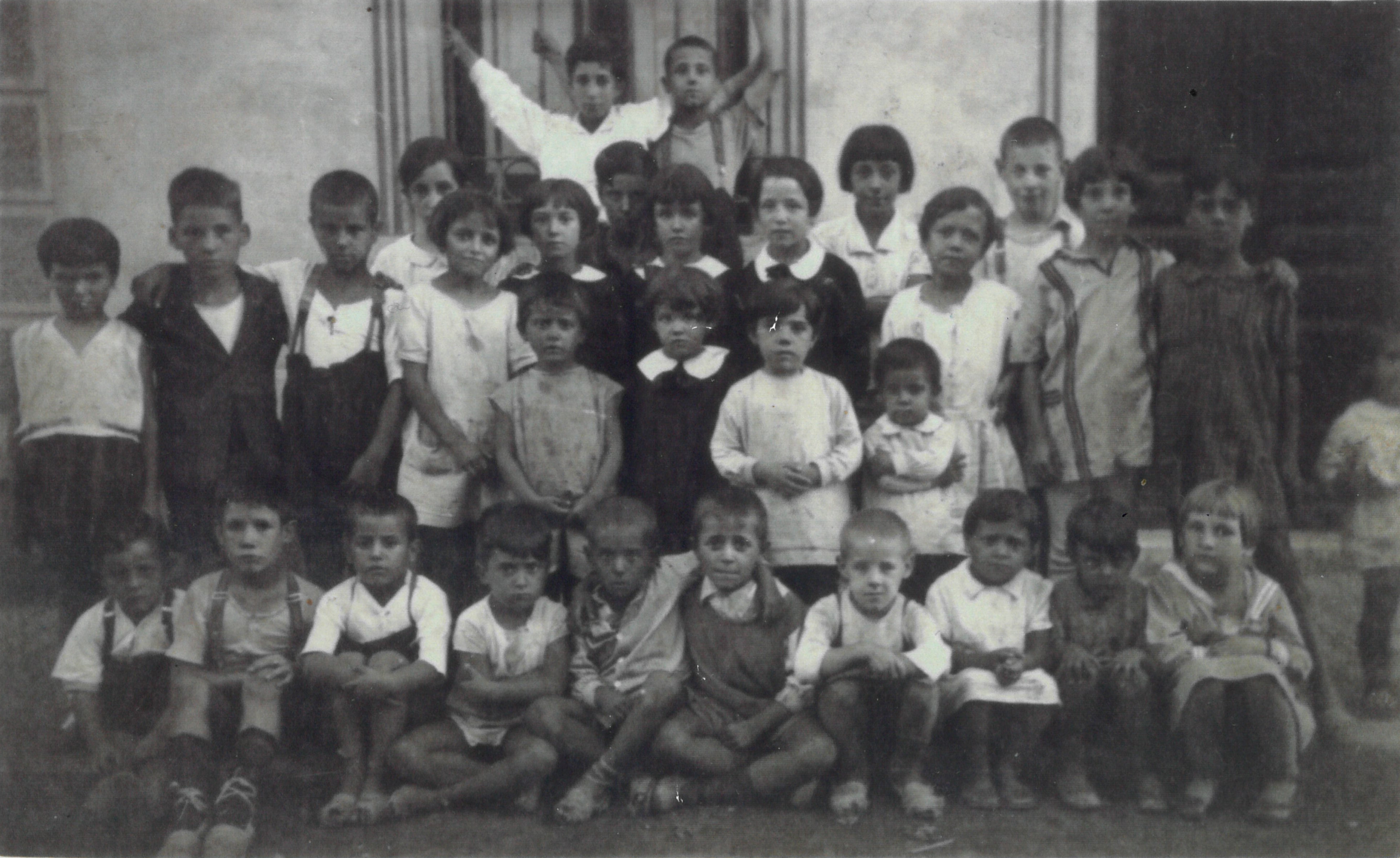The piece of text below is a shortened, hashed representation of this content. It is useful to ensure the content has not been tampered with, as a single modification would result in a totally different value.
Value:
f5395858d87d2b033a06f01d960e59cb410ff8aaf9956b8faddaa960e1f3da55
Source:
{"body":{"ca":"<h5><strong>🎙️ Documentació col·lectiva </strong></h5><p>La cedent de la fotografia comenta que l'ha portat al Banc de Memòria Viva per les expressions de les cares dels nens i nenes. Creu que entre ells es troben el seu pare o el seu tiet. No sap exactament de quina escola es podria tractar, però de fons identifica el Passatge Arquitecte Millàs. Una participant comenta que potser la foto és d'abans de la guerra, atès que apareixen nens i nenes junts. Tal vegada, podrien ser alumnes de l'escola de la Cooperativa dels Tramviaires o la de l'Esperança. La conversa flueix reflexionant sobre l'ensenyament durant la postguerra i sobre vivències d'infància vinculades a les porteries dels edificis.</p><h6><strong>Ensenyament durant la postguerra</strong></h6><p>Les escoles privades i religioses tenien els seus grans espais, com per exemple, les dels Jesuïtes. Les altres escoles se situaven en pisos petits, eren les anomenades \"escoles de districte\". L'ensenyament era en castellà i el català estava prohibit. \"En entrar, tocava cantar \"Arriba España\" i, en sortir, el \"Cara al Sol\"\". Una participant destaca que era un panorama molt diferent al de la mancomunitat dels anys 20 on es va aprovar construir noves escoles que fossin \"com palaus per als nens i nenes\". Com per exemple, l'escola Ramon Llull o la Baixeras, edificis majestuosos que encara veiem a Barcelona. Tots dissenyats per l'arquitecte Goday.</p><p>La dictadura va impactar molt en els mestres: \"Tots, tots, tots els mestres d'aquest país, van passar per un procés de depuració\". Per exemplificar com durant la dictadura es van inhabilitar o, fins i tot, afusellar, a mestres marcadament d'esquerres, una participant cita la pel·lícula \"El mestre que va prometre la mar\". Avui dia, hi ha un monument al Camp de la Bota que ret homenatge a totes les persones afusellades durant la dictadura.</p><p>Els/les participants ressalten que, si bé durant la Guerra Civil va haver-hi atrocitats per part de tots els bàndols, en finalitzar-se, la guerra va acabar per a uns, però no per a tots. Franco va signar sentències de mort fins a l'últim moment. Com és el cas de Salvador Puig Antich, fa 50 anys. Una participant recorda com va viure ella mateixa i gent del seu voltant la nit abans de la seva execució: \"Jo em repetia a mi mateixa \"(Franco) no serà capaç, no serà capaç...\", uns altres bevien sense parar, uns altres s'amagaven per por de ser ells els següents, uns altres resaven...\".</p><h6><strong>Records d'infància a la porteria</strong></h6><p>En recordar la infància, un participant comenta que va passar la seva infància en una porteria, ja que el seu pare era el porter. Una participant comenta que a Barcelona sobretot eren les dones les porteres. Comparteix que hi ha estudis que analitzen com moltes dones que van emigrar del camp van començar a treballar de porteres, perquè, en ocupar la porteria, els estaven garantint una llar a les seves famílies. A més, en relacionar-se amb els senyors de l'edifici també podien guanyar diners extres, per exemple, netejant-los les seves cases. El problema era que en jubilar-se es quedaven sense llar.</p><h5><strong>👥Autors i autores de la documentació</strong></h5><p>Pilar, Mercè, Neus i Enric.</p><h5>⚙️<strong> Metodologia</strong><br></h5><p>Fotografia documentada col·lectivament per veïns i veïnes participants del grup <a href=\"about:blank\" rel=\"noopener noreferrer\" target=\"_blank\">Fem Memòries del Canòdrom</a><br></p><h5><strong>📸 Cedent</strong><br></h5><p>Neus Garrido (cedent)</p><div class=\"editor-content-image\" data-image=\"\"><img src=\"https://comunitat.canodrom.barcelona/rails/active_storage/blobs/redirect/eyJfcmFpbHMiOnsibWVzc2FnZSI6IkJBaHBBcElnIiwiZXhwIjpudWxsLCJwdXIiOiJibG9iX2lkIn19--f0ed630043099b1a91399521503fb0581560610d/memories3_3.jpeg\" alt=\"\"></div>","en":"<h5><strong>🎙️ Documentació col·lectiva </strong></h5><p>The person who provided the photograph comments that they brought this picture to the Living Bank Memory because of the expressions on the children's faces. They believe that among them might be their father or uncle. They're not exactly sure which school it could be, but in the background, they identify the Arquitecte Millàs street. One participant suggests that perhaps the photo was taken before the Spanish Civil War, as boys and girls appear together; perhaps they could be students of the Cooperative School of Tramway Workers or the Esperanza School. The conversation flows, reflecting on post-war education and childhood experiences linked to the doorways of homes.</p><h6><strong>Post-war Education</strong></h6><p>Private and religious schools had large spaces, such as those run by the Jesuits. Other schools were located in small apartments, known as \"district schools.\" Instruction was in Spanish, and Catalan was prohibited. \"Upon entering, we had to sing “¡Arriba España!” and upon leaving, “Cara al Sol”\". One participant highlights that it was a very different panorama from the period of the 1920s when it was approved to build new schools that would be \"like palaces for children.\" For example, the Ramon Llul or Baixeras schools, majestic buildings still seen in Barcelona, all designed by the architect Goday.</p><p>The dictatorship had a significant impact on teachers: \"All, all, all the teachers in this country went through a process of purification.\" They disqualified or executed teachers with strong leftist leanings. To illustrate, one participant mentions the film \"The teacher who promised the sea.\" Today, there is a monument in Camp de la Bota that pays tribute to all those executed during the dictatorship.</p><p>Participants emphasize that while there were atrocities committed by all sides during the Civil War, when it ended, the war ended for some, but not for all. Franco signed death sentences until the very end. Such is the case of Salvador Puig Antich, 50 years ago. One participant recalls how she and those around her experienced the night before his execution: \"I kept telling myself '(Franco) won't do it, he won't do it,...', others drank non-stop, others hid for fear of being next, others prayed...\".</p><h6><strong>Childhood memories in the doorway</strong></h6><p>When recalling childhood, one participant mentions spending theirs in a doorway because their father was the gatekeeper. Another participant notes that in Barcelona, especially, it was mainly women who were gatekeepers. They share that there are studies analyzing how many women who migrated from rural areas started working as gatekeepers because by occupying the doorway, they were guaranteeing a home for their families. Additionally, by interacting with the building's residents, they could also bring in extra money, for example, by cleaning their homes. The problem was that upon retirement, they were left homeless.</p><h5><strong>👥Authors of the documentation</strong></h5><p>Pilar, Mercè, Neus i Enric.</p><h5>⚙️<strong> Methodology</strong><br></h5><p>Photograph documented collectively by participating neighbors in the group <a href=\"about:blank\" rel=\"noopener noreferrer\" target=\"_blank\">Fem Memòries del Canòdrom</a><br></p><h5><strong>📸 Assignor</strong><br></h5><p>Neus Garrido (assignor)</p><div class=\"editor-content-image\" data-image=\"\"><img src=\"https://comunitat.canodrom.barcelona/rails/active_storage/blobs/redirect/eyJfcmFpbHMiOnsibWVzc2FnZSI6IkJBaHBBcElnIiwiZXhwIjpudWxsLCJwdXIiOiJibG9iX2lkIn19--f0ed630043099b1a91399521503fb0581560610d/memories3_3.jpeg\" alt=\"\"></div>","es":"<h5><strong>🎙️ Documentación colectiva </strong></h5><p>La cedente de la fotografía comenta que ha traído esta fotografía al Banco de Memoria Viva por las expresiones de las caras de los niños. Cree que entre ellos se encuentran su padre o su tío. No sabe exactamente de qué escuela se podría tratar, pero de fondo identifica el Passatge Arquitecte Millàs. Una participante comenta que tal vez la foto es de antes de la guerra, dado que aparecen niños y niñas juntos, tal vez, podrían ser alumnos de la escuela de la Cooperativa de los Tranviarios o la de la Esperanza. La conversación fluye reflexionando sobre la enseñanza durante la posguerra y sobre vivencias de infancia vinculadas a las porterías de los hogares.</p><h6><strong>Enseñanza durante la posguerra</strong></h6><p>Las escuelas privadas y religiosas tenían sus grandes espacios, como por ejemplo, las de los Jesuitas. Las otras escuelas se ubicaban en pisos pequeños, eran las llamadas “escuelas de distrito”. La enseñanza era en castellano y el catalán estaba prohibido. “Al entrar, tocaba cantar ¡Arriba España! y, al salir, el Cara al Sol”. Una participante destaca que era un panorama muy distinto al de la mancomunidad de los años 20 donde se aprobó que se harían nuevas escuelas que serían “como palacios para los niños”. Como por ejemplo, la escuela Ramon Llull o la Baixeras, edificios majestuosos que aún vemos en Barcelona, todos diseñadas por el arquitecto Goday.</p><p>La dictadura impactó mucho en los maestros: “Todos, todos, todos los maestros de este país, pasaron por un proceso de depuración”. Inhabilitaron o fusilaron a maestros marcadamente de izquierdas. Para ejemplificarlo, una participante cita la película “El maestro que prometió el mar”. A día de hoy, hay un monumento en el Camp de la Bota que rinde homenaje a todas las personas fusiladas durante la dictadura.</p><p>Los/las participantes resaltan que, si bien durante la Guerra Civil hubo atrocidades por parte de todos los bandos, al finalizarse, la guerra terminó para unos, pero no para todos. Franco firmó sentencias de muerte hasta el último momento. Como es el caso de Salvador Puig Antich, hace 50 años. Una participante recuerda como vivió ella misma y gente de su alrededor la noche antes de su ejecución “yo me repetía a mí misma “(Franco) no será capaz, no será capaz,...”, otros bebían sin parar, otros se escondían por miedo de ser ellos los siguientes, otros rezaban...”.</p><h6><strong>Recuerdos de infancia en la portería</strong></h6><p>Al recordar la infancia, un participante comenta que pasó su infancia en una portería, ya que su padre era el portero. Una participante comenta que en Barcelona sobre todo eran las mujeres las porteras. Comparte que hay estudios que analizan como muchas mujeres que emigraron del campo empezaron a trabajar de porteras, ya que, al ocupar la portería, les estaban garantizando un hogar a sus familias. Además, al relacionarse con los señores del edificio también podían llevar dinero extra a sus casas, por ejemplo, limpiándoles sus casas. El problema era que al jubilarse se quedaban sin hogar.</p><h5><strong>👥Autores y autoras de la documentación</strong></h5><p>Pilar, Mercè, Neus y Enric.</p><h5>⚙️<strong> Metodología</strong><br></h5><p>Fotografía documentada colectivamente para vecinos y vecinas participantes del grupo <a href=\"about:blank\" rel=\"noopener noreferrer\" target=\"_blank\">Fem Memòries del Canòdrom</a><br></p><h5><strong>📸 Cedente</strong><br></h5><p>Neus Garrido (cedente)</p><div class=\"editor-content-image\" data-image=\"\"><img src=\"https://comunitat.canodrom.barcelona/rails/active_storage/blobs/redirect/eyJfcmFpbHMiOnsibWVzc2FnZSI6IkJBaHBBcElnIiwiZXhwIjpudWxsLCJwdXIiOiJibG9iX2lkIn19--f0ed630043099b1a91399521503fb0581560610d/memories3_3.jpeg\" alt=\"\"></div>"},"title":{"ca":"Ensenyament abans i després de la Guerra Civil","en":"Education before and after the Spanish Civil War","es":"Enseñanza antes y después de la Guerra Civil"}}
This fingerprint is calculated using a SHA256 hashing algorithm. In order to replicate it yourself, you can use an MD5 calculator online and copy-paste the source data.



.png)



Share